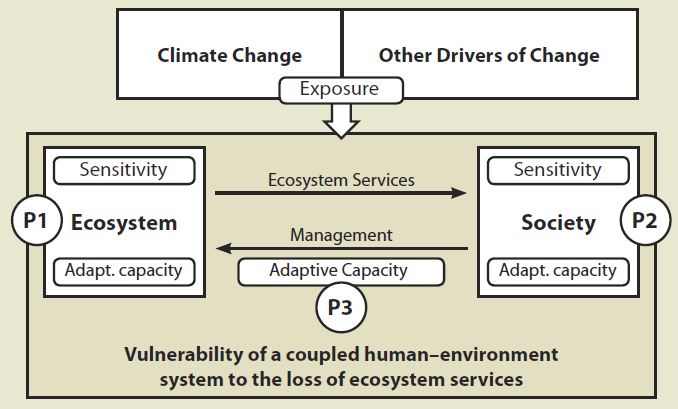
- TroFCCA
- The project
- Methods and activities
Methods and activities
Approach
Focus on development
TroFCCA’s approach placed forest ecosystems in the context of development. The starting point was to identify the development priorities and policies in which forest ecosystems play a role for adaptation to climate change, or for which forest degradation is a factor of vulnerability. The assessment of vulnerability was, therefore, directed at specific areas of development identified jointly by the project team and national stakeholders (primarily government representatives, national research institutions and the private sector).
Focus on vulnerability
Two main approaches are generally applied in assessments of social-ecological systems under climate change: “impact-based approaches” (or impact studies) and “vulnerability-based approaches”. Impact-based approaches are concerned with assessing the potential impacts of climate on system components under different scenarios. Vulnerability-based approaches start with assessing social sensitivity and adaptive capacity to respond to stresses, frequently combining this information with impact studies.
To facilitate adaptation processes for forest-dependent people and sectors, vulnerability-based approaches are more adequate. Most impact-based approaches have failed to facilitate social adaptation processes due to uncertainties and issues of scale (e.g. missed local specificities), and impact studies operate at a time horizon much further than the one relevant for decision-makers or immediate development needs.
TroFCCA used impact-based and vulnerability-based approaches in a complementary manner, in order to explore adaptation strategies that both provide for current needs and prepare for future hazards.
Focus on landscapes
Vulnerability and adaptation strategies were explored at the landscape level, recognising that the functional scale of ecosystems and their drivers typically span across broader spatial and temporal levels. Landscape-level approaches acknowledge that ecosystem benefits and management costs can occur in different locations and affect different sectors and divisions of society. These approaches are to identify the cumulative and indirect drivers of both ecosystem and social vulnerability, as well as for effective and sustainable cross-sectoral adaptation.
Activities
Five main activities were undertaken in each country:
- Compilation of methods to assess the vulnerability of specific development priorities and related forest ecosystems.
- Elaboration of integrated vulnerability assessments covering social and ecological components of defined systems.
- Development of criteria and indicators for adaptive management.
- Development of policy-oriented strategies for tropical forest ecosystems.
- Science–policy dialogue in and across regions.
Methodological Framework
A general framework allowed each region to develop tailored methods on the basis of their respective regional contexts. The framework defines a chain of linkages between variables at different levels as illustrated here:

A broad framework was also developed for vulnerability assessments, flexible enough so as to be applied to diverse ecosystem services in various contexts, such as non-timber forest products in West Africa or forest hydrological services in Central America.
The conceptual framework emphasises the role of ecosystem services for society. Three main sets of criteria are defined (see circles in the figure below). The first set (S1) deals with the vulnerability of ecosystem services to climate change or variability and other threats. It can be described by criteria related to exposure and sensitivity to climate change or variability, and ecosystem adaptive capacity as a function of current degradation or other pressures.
The second set (S2) deals with the human system and its vulnerability to the loss of ecosystem services. The sensitivity of the system (e.g. dependence on non-timber forest products or clean water) and its adaptive capacity (e.g. availability of substitutes for the lost services) can be used as criteria for S2. External drivers of changes, such as macroeconomic policies or energy prices, must also be taken into account in characterising this principle.
The third set (S3) considers the adaptive capacity of the system as a whole. It refers to the capacity of the human systems to reduce the loss of ecosystem services. Criteria can refer to the capacity of removing practices that increase pressures on ecosystems and the capacity to implement forest adaptation.



